Abbot Kinney Pier
Revised April 6, 1998
Venice of America's initial plans in 1904 called for a 900 foot long, 30 foot wide pleasure pier at the foot of Windward Avenue. The pier would feature a Casino and Bandstand Tower at the inland end of the pier, a Ship's Hotel that would resemble an ocean liner permanently docked beside the pier and an 3500 seat Auditorium to be used for the Venice Assembly.
Construction began on the pier in September 1904 and the contractor completed the main deck in November. He then began driving the pilings for the Casino and Auditorium. The buildings were nearly completed when two fierce winter storms in February and March 1905 destroyed the pier and its buildings. The beach was one vast pile of driftwood. Damage was $50,000.
Kinney gave the task of completing the pier and its buildings in time for the July 4th opening his highest priority. He purchased all 600 available piles in San Pedro, brought in four pile drivers, and put his men to work on day and night shifts. He also decided to lengthen the pier several hundred feet to the site of his $100,000 stone breakwater that he hoped would protect his pier from further storm damage.
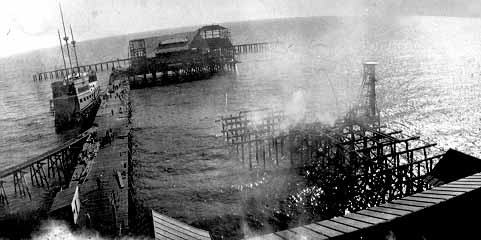
| Construction of the Abbot Kinney Pier at the foot of Windward Avenue. - June 1905 |
Pier construction reached the site of his breakwater the first week of May. By the time they began framing the pier's Auditorium on May 30th, they had only a month to complete the structure. Carpenters worked quickly and had the framework to the height of a three story building in only three days. It was important that the building, which contained 500,000 board feet of lumber, would be finished on time for the sixty day Venice Assembly. In fact, it was completed on time and worker's used it on Saturday July 1st to celebrate their feat of building the resort on time.
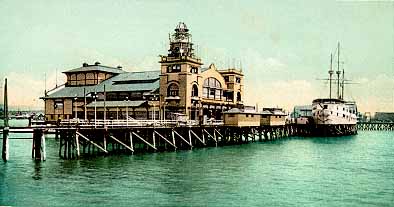
| View of Auditorium & Ship Cafe - 1906 |
After the end of summer, when the Venice Assembly ended with a loss of $16,000, Kinney decided instead to concentrate on the tastes of day-trip and summer holiday guests who preferred less intellectual pursuits. His plan was to expand the Frolic Pier which he began building on the north side of his pier and use it to house the shows and amusements from the Portland's Lewis and Clark Exposition. But in October 1905 he abandoned the idea for a much more roomy site at the Venice lagoon. Kinney found an alternative use for his pier auditorium during the off-season and converted it into the Venetian Gardens. It served refreshments to patrons seated at tables while Ellery's 52 member Royal Italian Band entertained from the stage.
Since ballroom dancing was an important social activity at all seaside resorts at the turn of the century, Kinney decided to built at a cost of $40,000, the finest and largest dance hall on the coast. He choose a site on the pier between the auditorium and the pavilion. Building material arrived on June 17, 1906 and an army of 125 carpenters and electricians attempted the herculean task of building it in just 17 days, in time for its July 4th dedication. While they didn't actually finish the building 190 x 210 foot building until the end of July, they managed to put up its walls, roof and complete its hardwood dance floor (14,560 square feet) in time for the celebration.
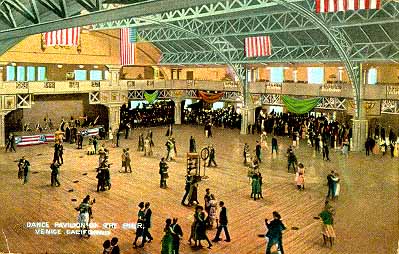 |
The Dance Hall's spacious floor could accommodate 800 couples. - 1906 |
Kinney's decision to turn the pier into a full scale amusement zone was made in 1909 when Kinney abandoned the lagoon midway concept entirely. Unfortunately there was no place to put the amusements on the beach since they were deeded to the city with the provision that they could never be commercialized. With all the ocean front lots sold or built upon, Kinney had no choice but to expand on the Atlantic City pier concept in a much bigger way.
The Aquarium, when it opened in January 1909, was the first of Kinney's new amusement pier attractions. It exhibited the finest collection of marine specimens on the Pacific Coast in 48 glass tanks surrounding a sunken seal tank. Sea Lion shows were performed near the entrance.
In January 1910 the L.A. Thompson Company announced that they would construct a one and one half mile scenic railroad behind the dance hall and pavilion on the north side of the pier. Kinney added several small concessions on the pier's south side. These included a Dentzel Carousel, a Hades attraction, a Japanese Tea House and the Ocean Inn restaurant. These attractions supplemented the bowling alleys located in the Pavilion. The pier was also widened to eliminate congestion.
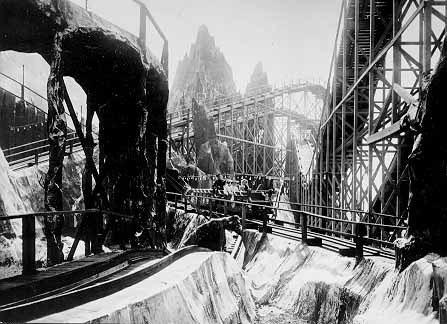 |
The scenic railroad had two lift hills and a brakeman to slow down the cars on turns. - 1911 |
The following year a Ferris Wheel arrived from Seattle's Yukon-Pacific Exposition and was placed seaward of the Ship Cafe. A ride called the Automobile Races opened next to it. The Rapids, an old mill style ride with 14 foot long boats, opened in March adjacent to Ocean Front Walk on the pier's south side.
Later that year work was begun on the Johnson Captive Airplane ride. Plans were for a ten passenger airplane to travel along a cable track from a 114 foot high tower on the inland end to three other smaller towers further out on the pier. The problem was that the ride was poorly engineered. The heavy cars riding slack cables sometimes dipped down into the water. The builders solved the problem and the ride opened the following summer. However, when another aerial ride called the Dippy Dips opened shortly afterward on the opposite side of the pier, the Captive Airplanes couldn't compete and closed after only one year.
The Kinney Company procured a Virginia Reel ride in 1913 and placed directly across from the Ship Cafe. Passengers rode in tub shaped cars that freely rotated as it followed a serpentine track downhill. Near the end of the ride, the tubs would spiral inward then plunge down a steep drop at high speed into a darkened tunnel.
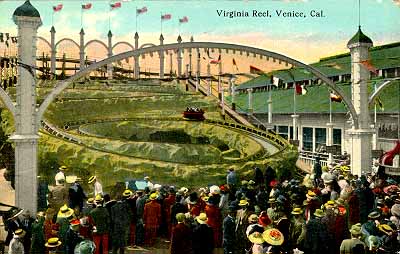
| The Virginia Reel's cars spun riders around as they serpentined down to the bottom. - 1913 |
In 1914 the Kinney Company spent $100,000 in improvements to the Abbot Kinney Pier. They added a free parking lot for 700 automobiles on the south side of the pier. Concessionaires, spending freely that year, added an Ostrich Farm across from the Dance Hall, a Zoological Garden at the end of the pier, an Underground Chinatown exhibit in the bandstand tower, and a skating rink on the site of the circular Automobile Races. They kept the hole in the center so that visiting sailors could watch the surf while they skated around the oval rink. The docks at the end of the pier serviced a 350 passenger boat that took passengers on a five mile excursion around Santa Monica Bay.
Improvements took a break during World War I, but the summer before it ended in 1918, Tom Prior moved his Great American Racing Derby horse race carousel from Ocean Park to Venice's pier. Actually it wasn't the same ride, but a slightly larger one operated under a canvas tent. The Whip also opened that season just above the Virginia Reel.
Once the Armistice was signed in November 1918, the Kinney Company enlarged the outer tee on their pier. They added an indoor tunnel of love ride called Over the Falls neat to the Oriental Gardens. There was a new fun house next to it called Hellarity Hall and a new Cafeteria situated between the Dance Hall and bowling alleys.
What turned out to be the last improvements on the Venice Pier were made in 1920. Crandall razed his Venice Scenic Railroad and Prior and Church razed the Rapids to make room for a new thrilling roller coaster. The innovative Big Dipper featured dips on curves as well as straight-aways. It opened on May 8, 1920. They also opened a Mill Chutes next to it that combined the old mill style tunnel of love with a water toboggan slide at the end.
The 1500 seat California Theater was built on the site of the old coaster next to the pier. Others added a Noah's Ark fun house near the pier's entrance, and a Bug House and Pig Slide at the seaward end of the pier.
The night of December 20th was a cool night on the pier, where at 9:30 P.M. people were huddled around a gas heater in one of the upstairs loges of the Dance Pavilion. Suddenly the heater burst open and flames leaped to the nearby curtains, then to the roof timbers. There was no panic and the dancers downstairs left quickly. Ten minutes later the roof collapsed. Arthur Ranse, a volunteer fire fighter, was on the roof when it caved in. He was hurled into the seething furnace, but was rescued by some of the dancers and lay dying in a nearby hospital.
Flames spread quickly to the adjoining Virginia Reel, then to the Racing Derby and Auditorium. Fire fighters dipped their hoses into the nearby Plunge and Venice Lagoon. By 10 P.M. with the wind blowing towards shore, fire fighters conceded that the fire was out of control. Warnings were sent to all the merchants across Ocean Front Walk and the hotels along Windward Avenue to evacuate.
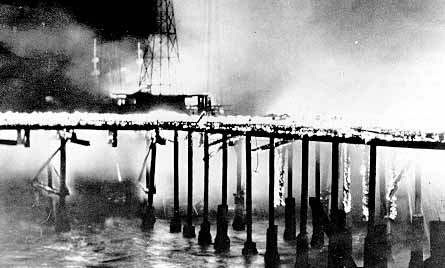
| The Abbot Kinney Pier burned in just a few hours on the night of December 20, 1920. |
Firemen used dynamite in a futile attempt to stop the fire at the pier's outer boundary. When this failed, Venice firemen, reinforced by fire companies from Santa Monica and Los Angeles, set up a mighty barrage of water to save the Ocean Front buildings. All seemed lost when suddenly the wind shifted and blew offshore at 11:30 P.M.
The next morning the pier was a smoldering ruin. All the pier's structures except the newly built roller coaster and the bandstand tower adjacent to Ocean Front Walk survived. Damages ran to a million dollars, with little of it insured. It was a bleak Christmas.